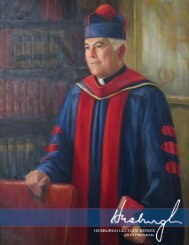HESBURGH LECTURE SERIES 2012 Program - Alumni Association ...
HESBURGH LECTURE SERIES 2012 Program - Alumni Association ...
HESBURGH LECTURE SERIES 2012 Program - Alumni Association ...
You also want an ePaper? Increase the reach of your titles
YUMPU automatically turns print PDFs into web optimized ePapers that Google loves.
Kathleen S. Cummings, Ph.D., ’95 M.A., ’99 Ph.D.<br />
Associate Professor, American Studies; Associate Director, Cushwa<br />
Center for the Study of American Catholicism<br />
Biography<br />
Kathleen Sprows Cummings is an associate professor of American studies at the University<br />
of Notre Dame. She is also the Associate Director of the Cushwa Center for the Study of<br />
American Catholicism, and she holds concurrent appointments in the Departments of History<br />
and Theology. Her teaching and research interests include the history of women and American<br />
religion and the study of U.S. Catholicism. Her first book, New Women of the Old Faith: Gender<br />
and American Catholicism in the Professive Era, appeared in 2009 with the University of North<br />
Carolina Press. At present, Cummings is working on a new book: Citizen Saints: Catholics and<br />
Canonization in American Culture. Cummings received an NEH Fellowship to support work on<br />
this project during the academic year 2010-11.<br />
Lectures<br />
American Saints: Catholics and Canonization in the United States<br />
In the 1880s, U.S. Catholics began to seek a saint of their own. Although it would be almost a century before Elizabeth Ann<br />
Seton was canonized as the first native-born American saint, U.S. Catholics rallied behind a number of causes in a manner that<br />
often revealed as much about their relationship to American culture as it did about the candidates for canonization. This lecture<br />
examines themes of mission, immigration, religious life, and American citizenship in the causes for canonization of the nine<br />
American saints as well as in a number of other open causes. It also explains the essential stages of the modern canonization<br />
process, with a particular focus on the changes to the process implemented by Pope John Paul II.<br />
Beyond Nunsense: Teaching Sisters and Catholic Schools in American History<br />
The image of the ruler-wielding nun is ubiquitous in American popular culture, but how much do we really know about teaching<br />
sisters? For every crazed nun who waved a ruler, there were literally hundreds of others who spent their entire adult lives serving<br />
patiently and faithfully in overflowing classrooms, modeling educated leadership and Christian charity for generations of children<br />
who came mostly from immigrant and working class families. Without the heavily subsidized labor that Catholic sisters provided,<br />
U.S. Catholics would never have been able to build the largest private educational enterprise known to history. This lecture<br />
introduces some of the sisters who helped to create, expand, and sustain the American Catholic parochial school system, and<br />
examines why religious life represented an attractive option for thousands of American Catholic women in the nineteenth and<br />
twentieth centuries. It also makes clear that if Catholics today are among the wealthiest, best educated and most accomplished<br />
Americans, it is Catholic sister-teachers who deserve the lion’s share of the credit.<br />
Categories<br />
Church, History<br />
The Hesburgh Lecture Series, <strong>2012</strong> <strong>Program</strong> 31



